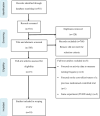Turning frequency in adult bedridden patients to prevent hospital-acquired pressure ulcer: A scoping review
- PMID: 29243356
- PMCID: PMC7949701
- DOI: 10.1111/iwj.12855
Turning frequency in adult bedridden patients to prevent hospital-acquired pressure ulcer: A scoping review
Abstract
The aim of this study was to identify current research on turning frequencies of adult bed-bound patients and inform future turning practices for hospitals based on evidence-based practice. We undertook a scoping review framework that provided a transparent and systematic methodology using 8 electronic databases (CINAHL, PubMed, Cochrane Library, ScienceDirect, PsycINFO, Scopus, ProQuest, and Web of Science) to identify articles published from 2000 to 2016. Articles were included if they focused on the prevention of hospital-acquired pressure ulcers related to the frequency of turning or repositioning of bed-bound patients. Literature search and data extraction were performed independently by 3 authors. The study followed the PRISMA guidelines. In total, 911 articles were identified, of which 10 were eligible. Of the eligible articles, 8 studies could not reach a conclusion on the effective frequency of turning and duration for repositioning patients to prevent the development of pressure ulcers. Only 2 studies found significant differences among the intervention and control groups. Results regarding turning and repositioning schedules are inconclusive; however, the topic needs further exploration to improve the outdated guidelines surrounding pressure ulcer prevention. This may, in turn, make the work of nurses more efficient and make treatment cost-effective for both the patients and the hospitals.
Keywords: pressure injury; pressure ulcer; repositioning; scoping review; turning.
© 2017 Medicalhelplines.com Inc and John Wiley & Sons Ltd.
Figures


References
-
- National Pressure Ulcer Advisory Panel, European Pressure Ulcer Advisory Panel, Pan Pacific Pressure Injury Alliance . Prevention and Treatment of Pressure Ulcers: Quick Reference Guide; 2014; http://www.epuap.org/wp-content/uploads/2016/10/quick-reference-guide-di.... Accessed May 18, 2017.
-
- Smith IL, Nixon J, Brown S, Wilson L, Coleman S. Pressure ulcer and wounds reporting in NHS hospitals in England. Part 1: Audit of monitoring systems. J Tissue Viability. 2016;25(1):3–15. - PubMed
-
- Spilsbury K, Nelson A, Cullum N, Iglesias C, Nixon J, Mason S. Pressure ulcers and their treatment and effects on quality of life: hospital inpatient perspectives. J Adv Nurs. 2007;57(5):494–504. - PubMed
Publication types
MeSH terms
LinkOut - more resources
Full Text Sources
Other Literature Sources
Medical

